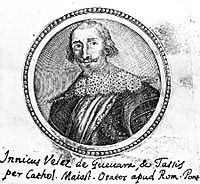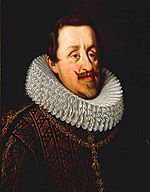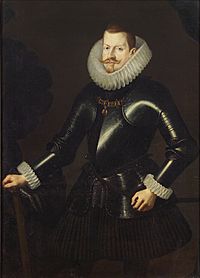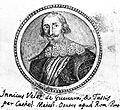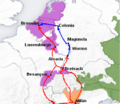Oñate treaty facts for kids
The Oñate Treaty was a secret treaty signed on July 29, 1617. It was an agreement between two powerful branches of the same royal family, the Habsburgs. One branch ruled Spain, and the other ruled Austria.
The treaty helped solve arguments over who would rule certain lands. King Philip III of Spain (from the Spanish Habsburgs) and Archduke Ferdinand II (from the Austrian Habsburgs) made the deal.
Philip III agreed that Ferdinand II should be the only Habsburg to become king of Bohemia and Hungary. This allowed Ferdinand to focus on problems in those kingdoms. In return, Ferdinand II gave Philip III control over lands along the "Spanish Road." This was a chain of Habsburg territories from Italy, through Alsace, to the Spanish Netherlands. This road was very important for Spain to move soldiers and supplies during the Eighty Years' War against the Dutch.
The treaty was named after Iñigo de Oñate. He was the Spanish ambassador in Vienna and helped negotiate the agreement.
Contents
Why the Treaty Was Needed
In 1612, Rudolph II, Holy Roman Emperor, died. His brother, Matthias, took his place. Matthias and other Austrian Habsburgs had no children. So, they agreed that Ferdinand II would inherit their lands.
However, King Philip III of Spain also wanted to claim these lands for his sons. Philip's family branch was older and more powerful. He even claimed the title of Holy Roman Emperor.
A key advisor to Emperor Matthias was Cardinal Melchior Klesl. He wanted to make peace between Catholics and Protestants in the Holy Roman Empire. He worried that Ferdinand II, who strongly supported the Catholic Church, might make things worse.
What the Habsburgs Agreed To
Philip III's representatives, Baltasar de Zúñiga and Íñigo Vélez de Guevara, 7th Count of Oñate, worked on the deal.
Philip III agreed to accept Ferdinand II as the next ruler. But he had conditions. Philip's main goal was to secure the "Spanish Road." This land route connected Spanish lands in northern Italy to the Spanish Netherlands. The sea route was dangerous because Spain had lost many ships, and the Dutch blocked the Scheldt river. Philip wanted to restart the Eighty Years' War in Europe. He also wanted to control more areas in Italy, like Finale Ligure, to get better access to the Mediterranean Sea.
The final treaty was signed on July 29, 1617.
Philip III agreed to give up his claims to the thrones of Bohemia and Hungary. This was on the condition that the German princes would choose Ferdinand II as the next Holy Roman Emperor after Emperor Matthias died.
In return, Ferdinand II promised Philip III several important places. These included the town of Finale Ligure and the Principality of Piombino in Italy. He also gave up Austrian Habsburg rights to Ortenau and Alsace, which were important for the "Spanish Road."
The Spanish and Austrian Habsburgs kept the Oñate Treaty a secret from Cardinal Klesl.
What Happened Next
With support from Maximilian III, Archduke of Austria, and no opposition from Philip III, Ferdinand II became king of Bohemia in 1617 and Hungary in 1618. This made him a strong candidate to become the next Holy Roman Emperor.
Cardinal Klesl, who still wanted peace between Catholics and Protestants, was arrested in May 1618.
Emperor Matthias died on March 20, 1619. The people of Bohemia turned against Ferdinand II. In August 1619, they chose Frederick V, Elector Palatine, a Protestant leader, as their new king. The very next day, Ferdinand II was elected Holy Roman Emperor by the other German princes.
These events in Bohemia led to a major conflict. With help from the German Catholic League and Spain, Ferdinand II defeated the Bohemian forces. He expelled the "winter king" in the Battle of White Mountain on November 8, 1620.
Images for kids
See also
 In Spanish: Tratado de Oñate para niños
In Spanish: Tratado de Oñate para niños


